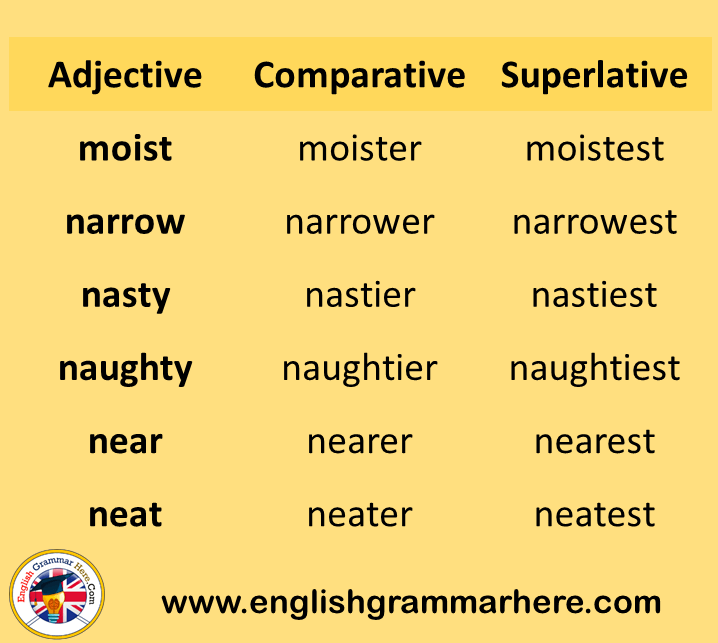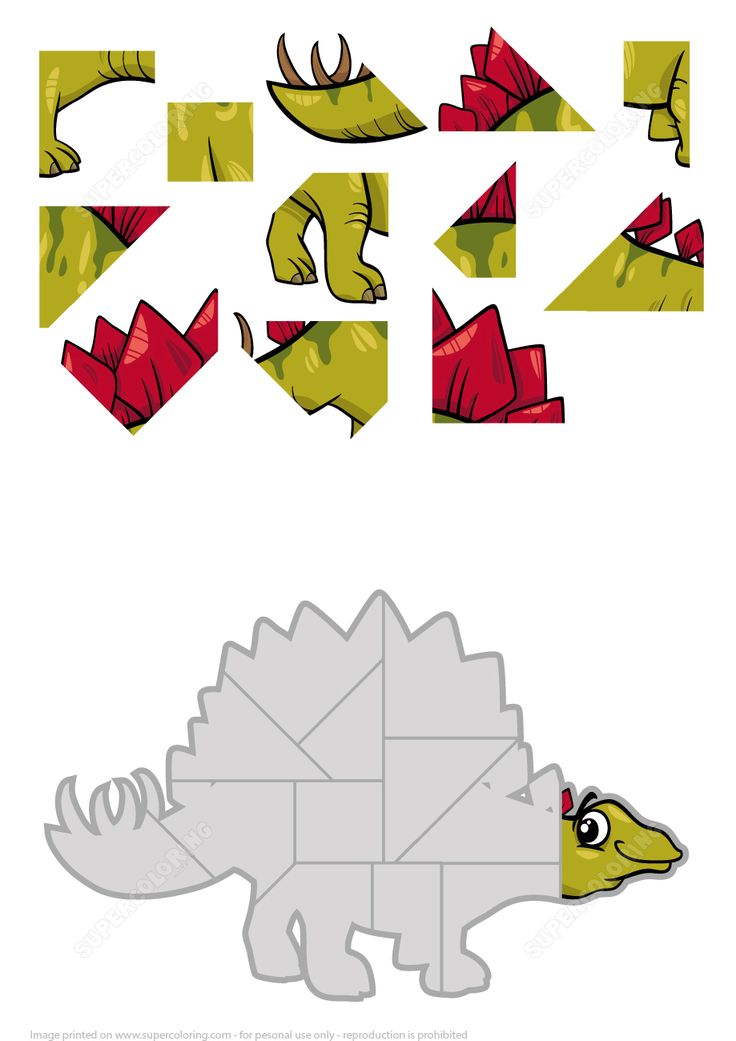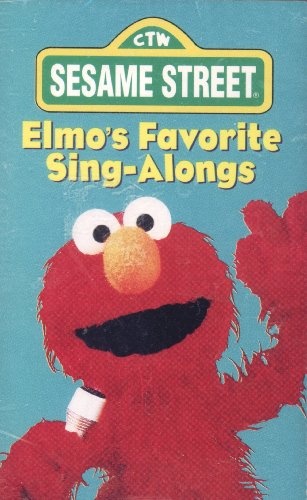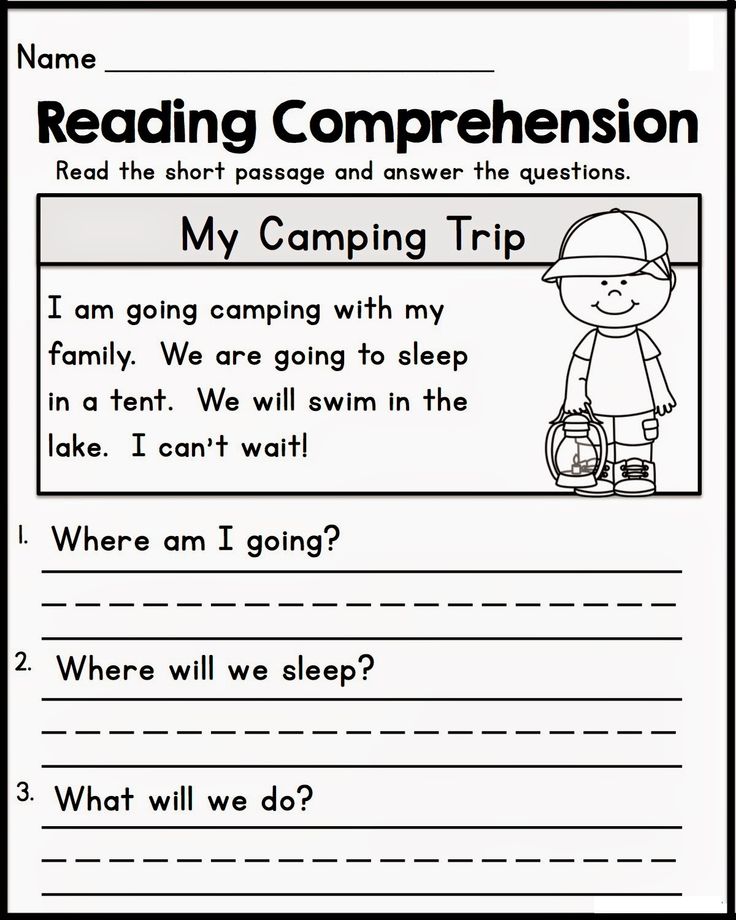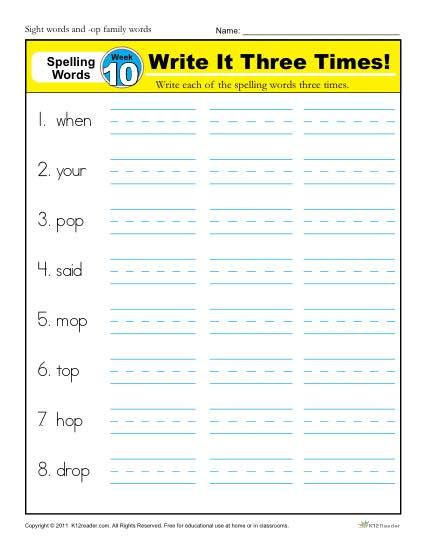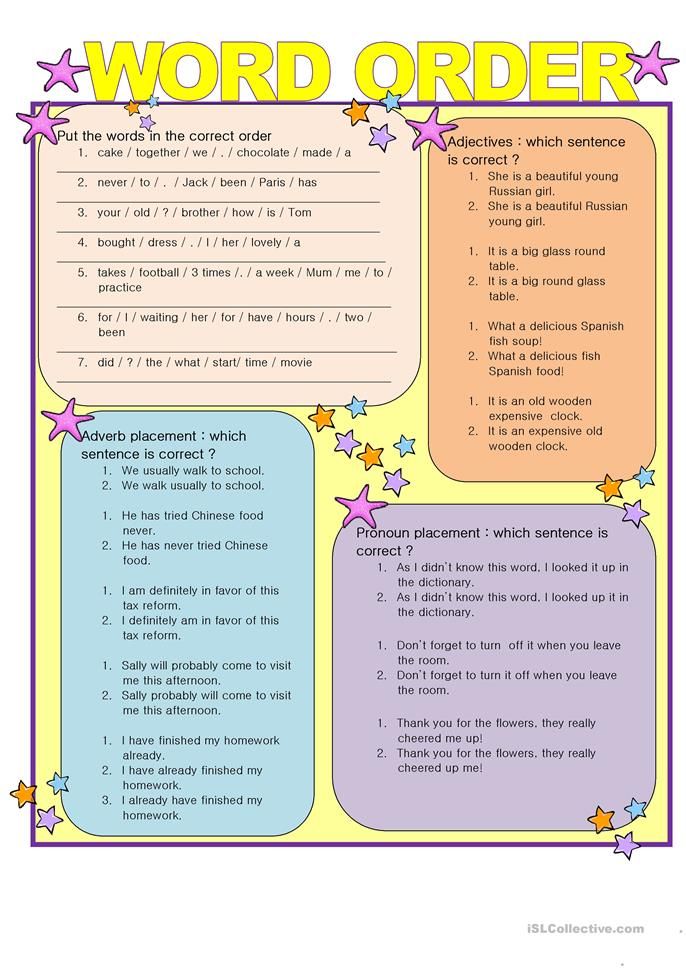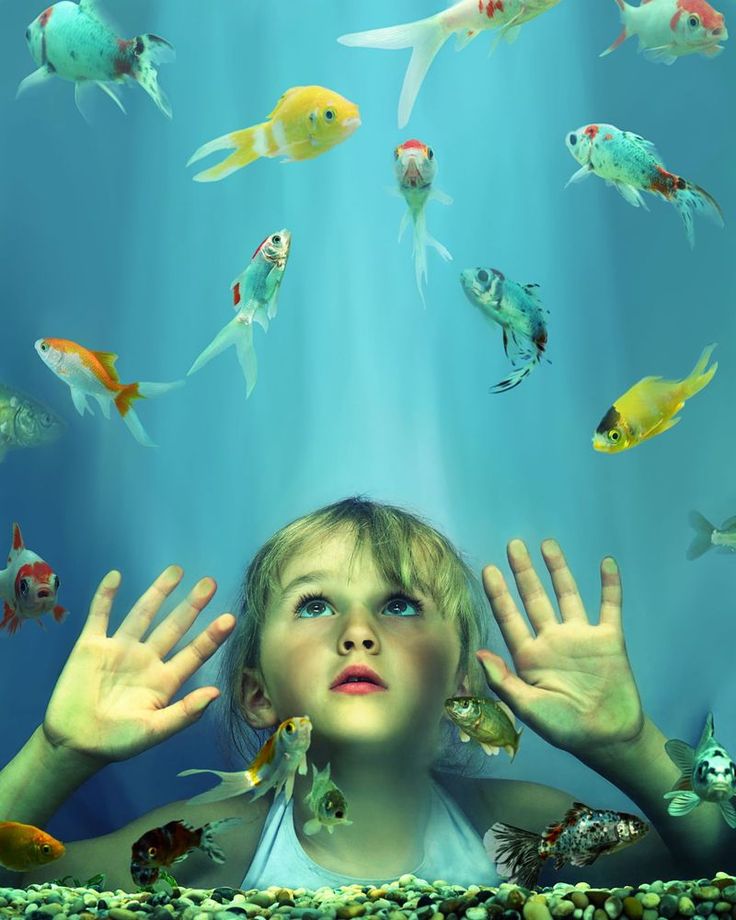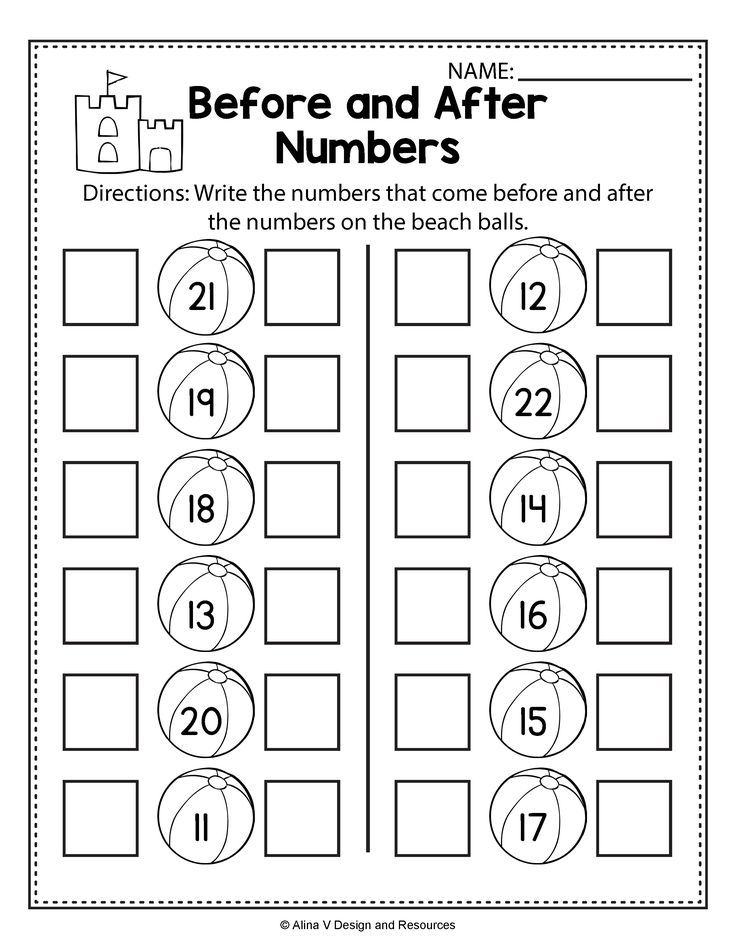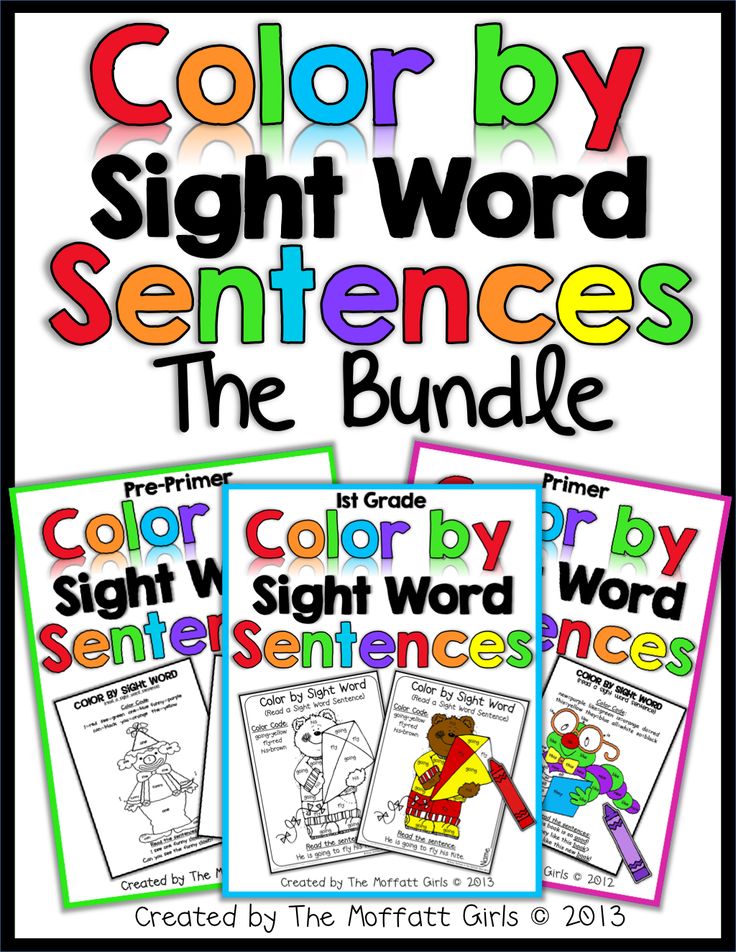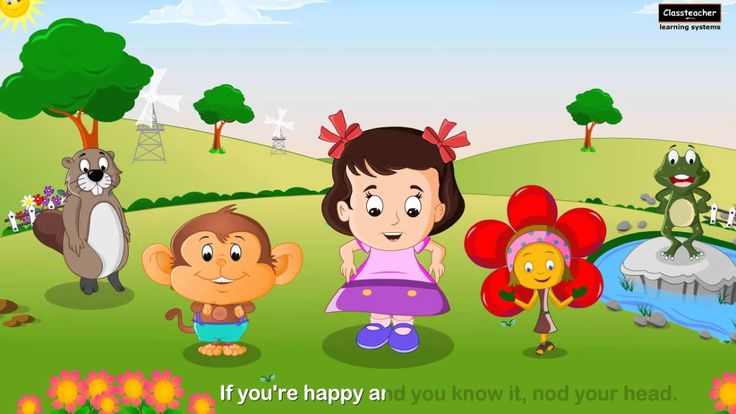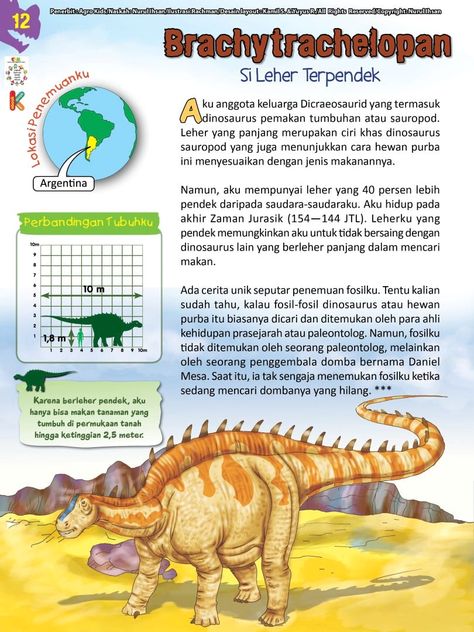Adjective definition kids
Adjective Facts for Kids
Kids Encyclopedia Facts
An adjective is a word that describes a noun or pronoun. Nouns are words that name a place, a person, a thing, or an idea. An adjective is a word that gives more information about the noun that goes with it. It is a part of speech.
Often, the adjective is before the noun it describes. Sometimes an adjective is not followed by a noun:
- The sky is blue.
- The joke she told was so funny, I could not stop laughing all day.
- It is still an adjective, because we could have "the blue sky", "the funny joke", and "the crazy man". The adjective is still describing the noun though they are not side by side.
- There is a tall man.
An adjective is a word that gives instant information about a noun to make a clear picture of the noun in the mind of the reader and create a feeling to the writer.
Contents
- Comparative and superlative
- Nouns as noun modifiers
- Adjectives and adverbs
- 100 Adjectives used in Basic English
Comparative and superlative
Sometimes there are different forms of the same adjective. If one joke makes a person laugh more than another joke, then that joke is funnier. This is called the comparative form. The day that is colder than any other is the coldest day. This is the superlative form of "cold". Some adjectives need additional words when we want to compare them. For instance, one car may be cheaper than another, but the second car may be more reliable (we use "more reliable", instead of "reliabler"). Reliable means worthy of trust.
The rule is:
For short adjectives ending in a consonant like "cold," "black," or "fast," one adds the suffix er to make a comparison of greater magnitude. Example: "The North Pole is colder than Florida." The greatest possible comparison is made by adding the suffix est. Example: "The North Pole is the coldest place on the Earth." For long adjectives like intelligent, conscientious, comprehensive, one uses the word more to make a comparison of greater magnitude. Example: "Children are more intelligent than adults.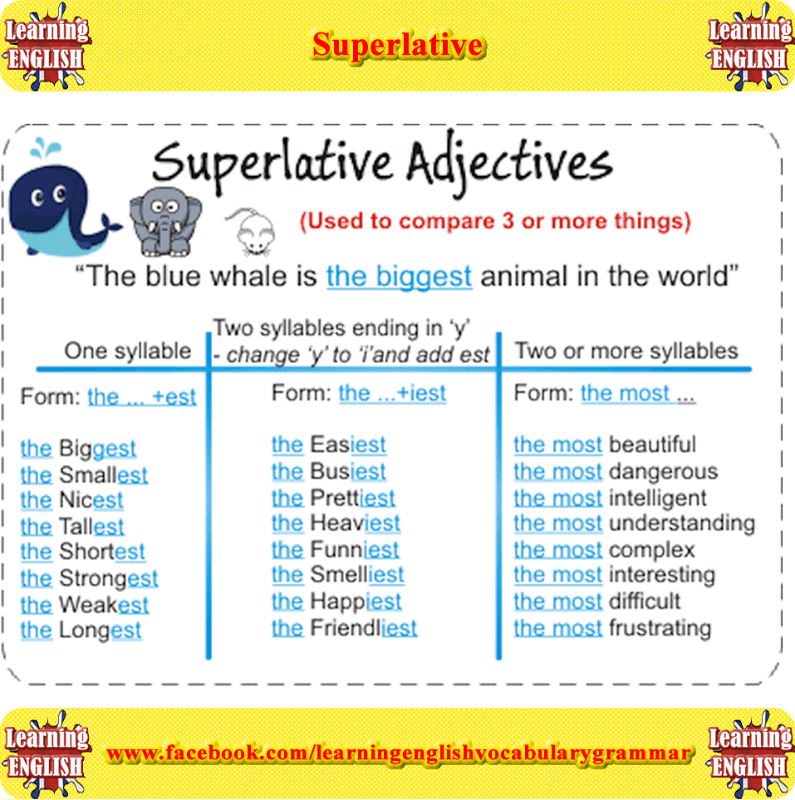 "
"
A superlative makes the greatest possible comparison. One uses the word most. Example: "She is the most conscientious person I have ever known."
Nouns as noun modifiers
In the English language, it is possible for a noun to modify (describe) another noun. Example: take the noun "angel" and the noun "face." Put them together and the result is "angel face." The first noun is acting as an adjective, because it is giving us information about the second noun.
Adjectives and adverbs
Adjectives are words we use to describe the noun. Simple words like "warm" and "fat" are adjectives commonly used in writing. One can make adverbs from some adjectives by adding the suffix ly. Example: take the adjective "beautiful," the adverb is beautifully. One can do it the other way around: take an adverb like "presumably," the adjective is "presumable". "Presumable innocence" means the accused is assumed to be innocent until proven guilty.
The adjective "guilty" becomes the adverb "guiltily" and vice versa (the opposite), the adverb "guiltily" becomes the adjective "guilty.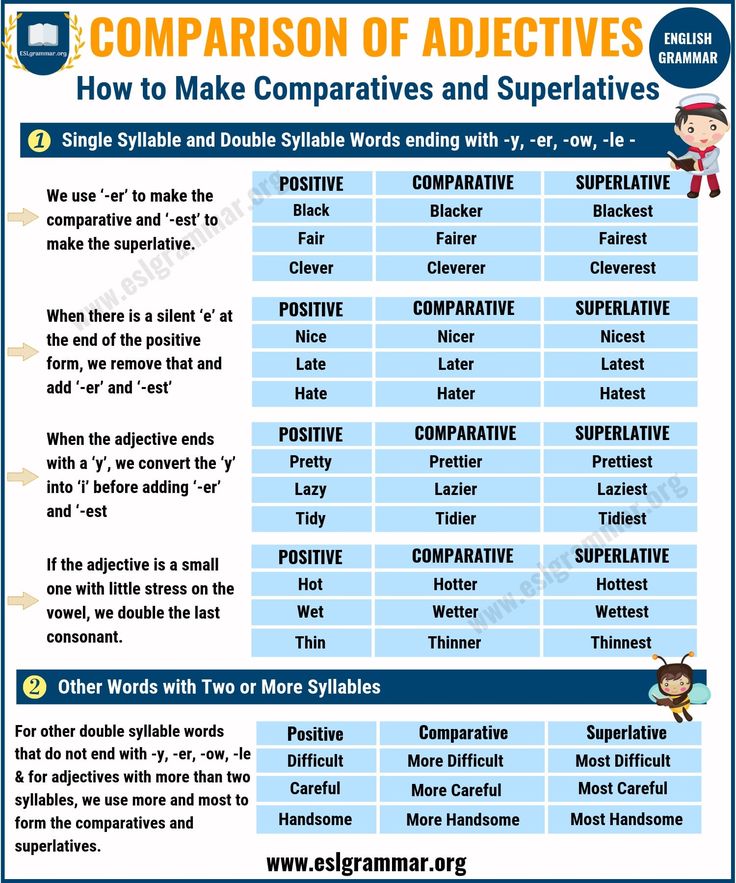 "
"
100 Adjectives used in Basic English
able • acid • angry • automatic • beautiful • black • boiling • bright • broken • brown • cheap • chemical • chief • clean • clear • common • complex • conscious • cut • deep • dependent • early • elastic • electric • equal • fat • fertile • first • fixed • flat • free • frequent • full • general • good • great • gray • hanging • happy • hard • healthy • high • hollow • important • kind • like • living • long • male • married • material • medical • military • natural • necessary • new • normal • open • parallel • past • physical • political • poor • possible • present • private • probable • quick • quiet • ready • red • regular • responsible • right • round • same • second • separate • serious • sharp • smooth • sticky • stiff • straight • strong • sudden • sweet • tall • thick • tight • tired • true • violent • warm • wet • wide • wise • yellow • young
All content from Kiddle encyclopedia articles (including the article images and facts) can be freely used under Attribution-ShareAlike license, unless stated otherwise.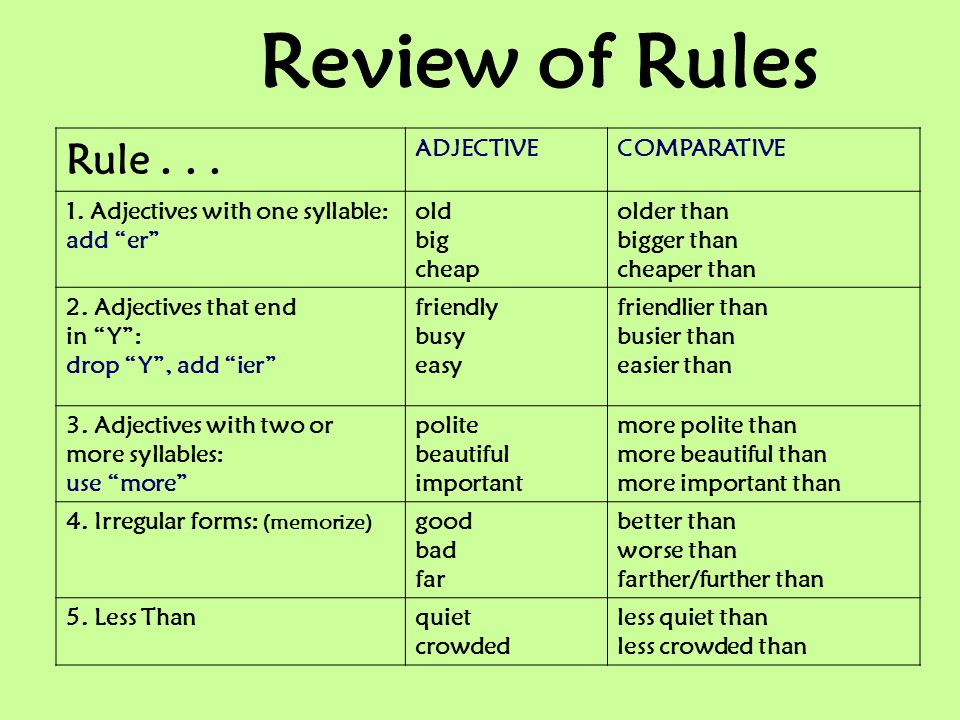 Cite this article:
Cite this article:
Adjective Facts for Kids. Kiddle Encyclopedia.
Adjectives for Kids
by Craig Shrives
This Page Includes...
- Video
- Printable & Sendable Test
What Are Adjectives? (for Kids)
Adjectives are describing words. In these examples, the highlighted words are all adjectives:
- a tall man
- a smelly street
- a tasty apple
Adjectives help us to create vivid images about people, places, or things. The words "man," "street," and "apple" are nouns. So, adjectives are words that describe nouns.
It's Your Go!
Select the adjective in each sentence:
Easy Examples of Adjectives
Here are some more examples of adjectives in sentences:
- Barney is a happy dog.
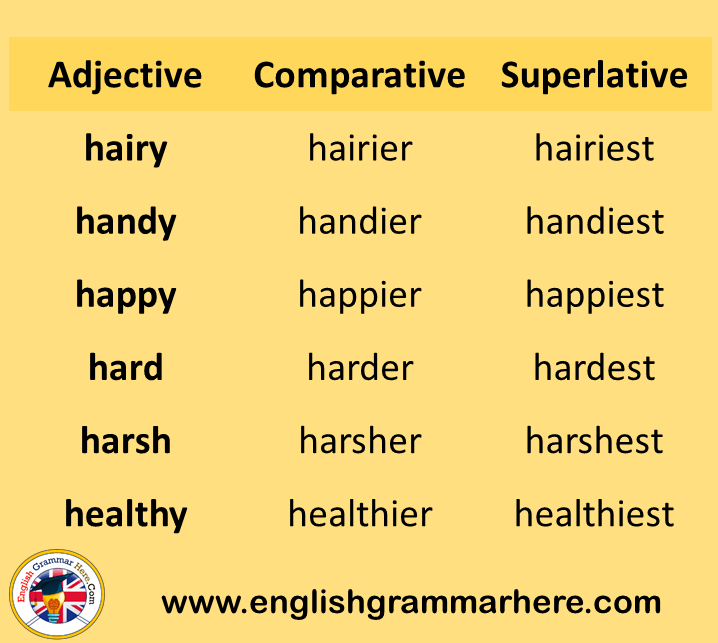
- She was an angry lady.
- It will be a cold night.
These adjectives describe the nouns "dog," "lady," and "night."
Using Stronger Adjectives
All the adjectives we've seen so far have provided simple descriptions. However, there are thousands of different adjectives, and many of them are quite sophisticated and give the writer exactly the right description. Here are some examples of stronger alternatives for the adjectives we've used so far:
| Simple Adjective | Stronger Adjectives |
|---|---|
| tall | towering, lanky |
| smelly | rancid, reeking, putrid, foul |
| tasty | delectable, scrumptious, delicious |
| happy | delighted, elated, joyful, merry |
| angry | bitter, annoyed, offended, enraged |
| cold | frigid, frosty, brisk, wintry |
To find the perfect adjective, writers often use a thesaurus to look for a strong alternative to a simple adjective that isn't quite right. Let's try one:
Let's try one:
- You have a clean car. ("Clean" is a simple adjective. A good writer would say it is a weak adjective.)
Here are some stronger alternatives from a thesaurus:
- immaculate, spotless, unblemished, shiny, sparkling
Let's rewrite our sentence with a stronger adjective:
- You have a spotless car.
Top Tip
Writers who find adjectives that fit perfectly do not use intensifiers like "very" and "extremely."
- Bobby is a very hungry dog. (This is not wrong, but it is poor writing. The writer used "very" because "hungry" is a weak adjective. It is too simple.)
- Bobby is a ravenous dog. (This time, the word "very" is not needed because "ravenous" is a strong adjective. It is more sophisticated.
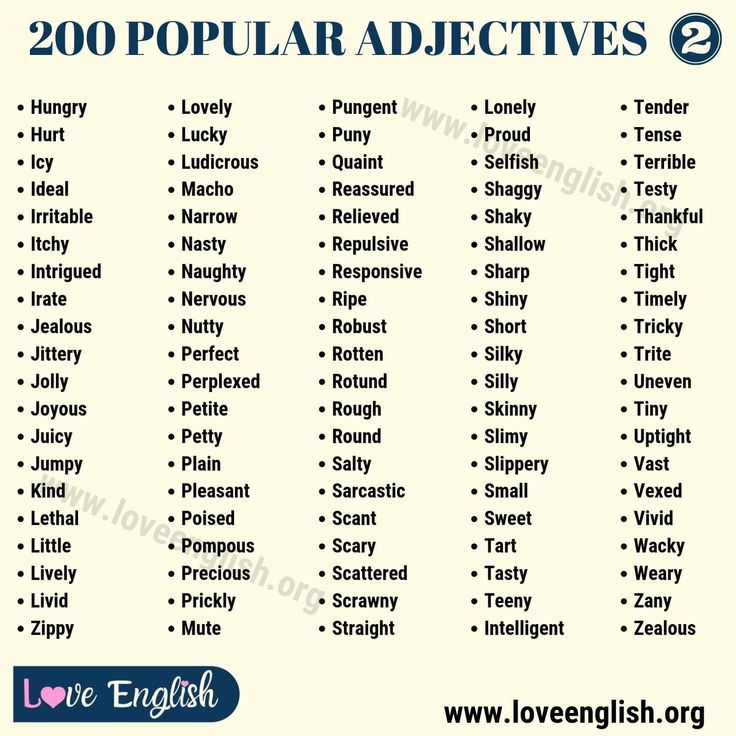 It is the exact word the writer wanted to express how hungry.)
It is the exact word the writer wanted to express how hungry.)
More about Adjectives
So far, all the adjectives we've seen have been positioned before nouns to describe them. However, as you learn to spot adjectives, you will soon notice that adjectives do not always go before nouns. Look at these examples:
- That girl is elegant. (This time, the adjective "elegant" describes the noun "girl" even though it appears afterwards.)
- Alan was foolish. (This time, the adjective "foolish" describes the noun "Alan" even though it appears afterwards.)
- The view from the mountain top will be stunning on Saturday. (This time, the adjective "stunning" describes the noun "view" even though it appears afterwards.)
Adjectives used like this are called predicate adjectives.
More about Predicate Adjectives
Predicate adjectives are used after linking verbs (e.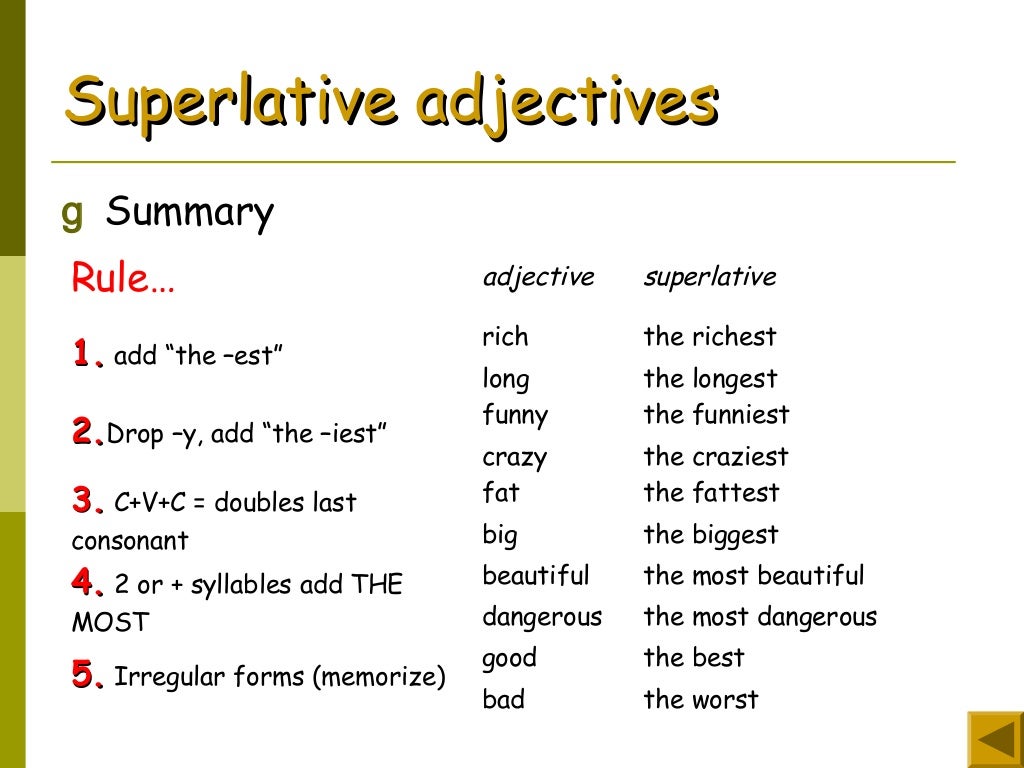 g., "to be," "to seem," "to smell"). For example (linking verbs in bold):
g., "to be," "to seem," "to smell"). For example (linking verbs in bold):
- The path is unsafe.
- The sea seems calm.
- The soup smells delicious.
Of interest, some adjectives (e.g., "afraid," "asleep," "alive," and "unable") are always predicate adjectives. In other words, they are only used after linking verbs.
- Toby is afraid.
- The troll looks asleep.
Other Ways to Describe Things
Choosing strong adjectives is an essential part of writing well. However, there are other ways to describe things. Let's look at some examples:
- The children were hungry. ("Hungry" is a weak adjective.)
- The children were ravenous. ("Ravenous" is a stronger adjective.)
- The children descended on the sandwiches like locusts.
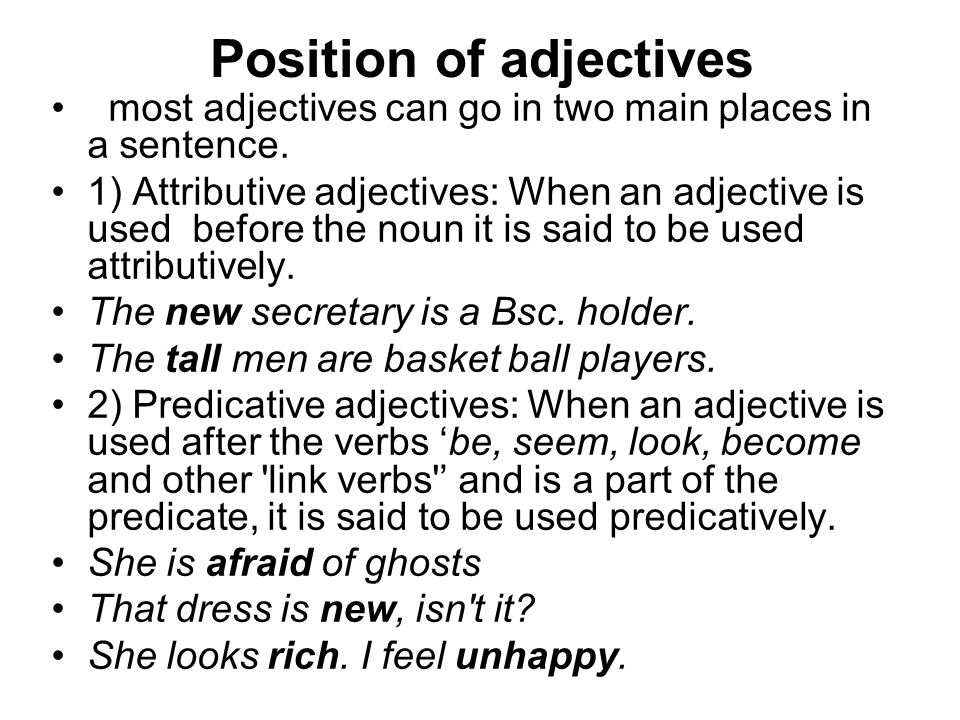 ("Descended on the sandwiches like locusts" is an example of a simile. It is a comparison used to provide a description.)
("Descended on the sandwiches like locusts" is an example of a simile. It is a comparison used to provide a description.)
- He had bad teeth. ("Bad" is a weak adjective.)
- He had rotten teeth. ("Rotten" is a stronger adjective.)
- He had teeth like smashed eagles' beaks. ("Like smashed eagles' beaks" is a simile.)
So, as well as looking for strong adjectives, you should also think about using comparisons like similes to provide vivid descriptions for your readers.
Video Lesson
Here is a video lesson giving more information about adjectives:
Printable Test
Help Us Improve Grammar Monster
- Do you disagree with something on this page?
- Did you spot a typo?
Find Us Quicker!
- When using a search engine (e.
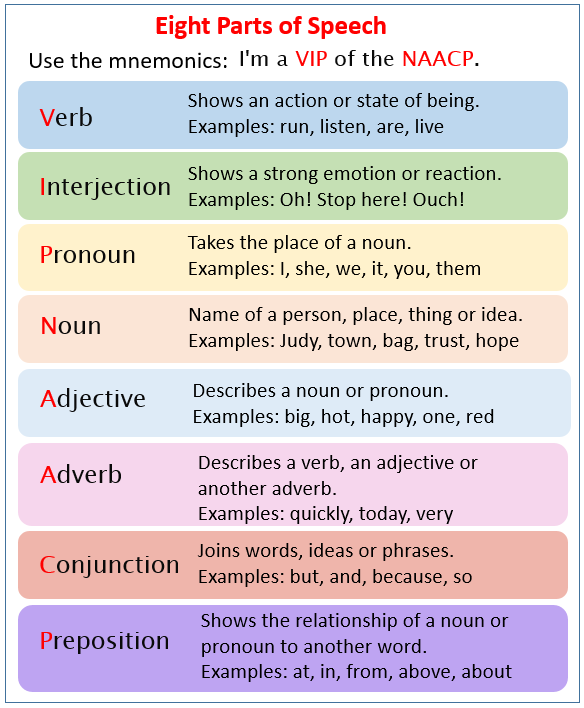 g., Google, Bing), you will find Grammar Monster quicker if you add #gm to your search term.
g., Google, Bing), you will find Grammar Monster quicker if you add #gm to your search term.
Next lesson >
See Also
adjectives for adult learnersa list of 2,000 adjectives to describe peoplea list of adjectives beginning with A, B, etc.Adverbs for kidsConjunctions for kidsNouns for kidsPrepositions for kidsPronouns for kidsInterjections for kidsVerbs for kids
Page URL
Technical Help
- Download the latest grammar-checker app.
Grammarly's app will help with:
(1) Avoiding spelling errors
(2) Correcting grammar errors
(3) Finding better words
(This free browser extension works with webmail, social media, and texting apps as well as online forms and Microsoft Office documents, like Word and Teams.)
Self Help
- Buy the grammar book that's right for you.
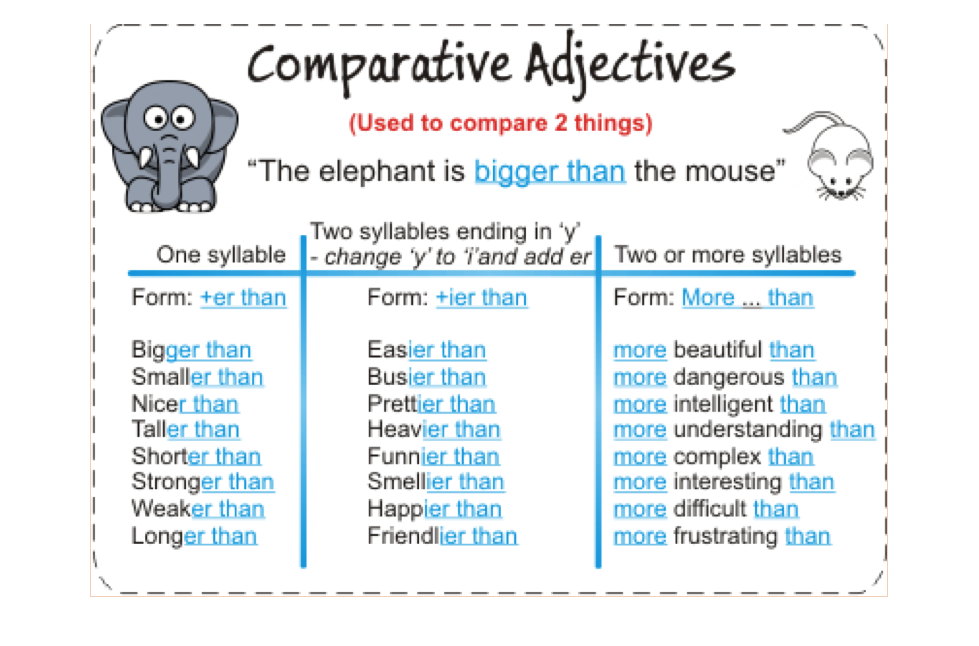
Hired Help
- Hire an online tutor from the British Council.
Games for Learning Adverbs
Here are some tests and games for learning about adjectives:
- Hangman with adjectives
- Find-the-adjectives test
- Adjectives game (bubble-pop game)
- Adverbs game (whack-a-word)
- Adverbs game (fish game)
Next lesson >
Adjective as a part of speech. Changing adjectives by gender and number
Objectives of the lesson: Generalize knowledge about the adjective as a part of speech; develop the ability to recognize adjectives in the text, to establish a connection adjectives with nouns, determine the gender and number of names adjectives, write generic endings correctly.
Equipment: interactive equipment (personal computer, whiteboard, projector), presentation for lesson (Attachment 1).
Course of the lesson
1. Organizational moment, (psychological mood), (Slide 1 .
Teacher: Guys, look carefully at the clouds. Which do you prefer Like? Children's answers.
I'm glad that most of you are in a good mood. Hope by the end everyone will be in a good mood during the lesson.
2. Actualization of acquired knowledge.
Teacher: Guys, today is an unusual lesson, we will travel around island of adjectives. But in order to reach it, we it is necessary to stop on the island of nouns and remember that we are talking about them we know. (Slide 2).
Well done I see that you are ready to leave the Island nouns to visit another, no less mysterious island is the Island of adjectives. Find out what role adjectives perform in our language, we will practice in determining the gender and number of adjectives to be able to speak correctly and beautifully. With you to journey take three nouns cornflower, cloud, river. But in order to get to the island of the Adjective, we need to remember which questions are answered by adjectives.
But in order to get to the island of the Adjective, we need to remember which questions are answered by adjectives.
Children: These are the questions: Which one? Which? Which? Which? (Slide 3).
Teacher:
So, let's go!
Paper boat,
But we are brave!
Dear parts of speech,
Get ready to meet again!
(Slide 4).
Teacher: We are on the island of adjectives. To loose on it move, answer the question: what do adjectives mean?
Children: A sign of an object.
Teacher: Look, adjectives came out to meet us. Read them. ( Children, looking at the slide, they read.)
Children: Ferocious, small, impudent, crooked, passerine, blue, black, bold, sad, magical, old, strong.
Teacher: What do all these adjectives have in common?
Children: All adjectives answer the question what? They stand in singular, masculine - this is the initial form of the adjective.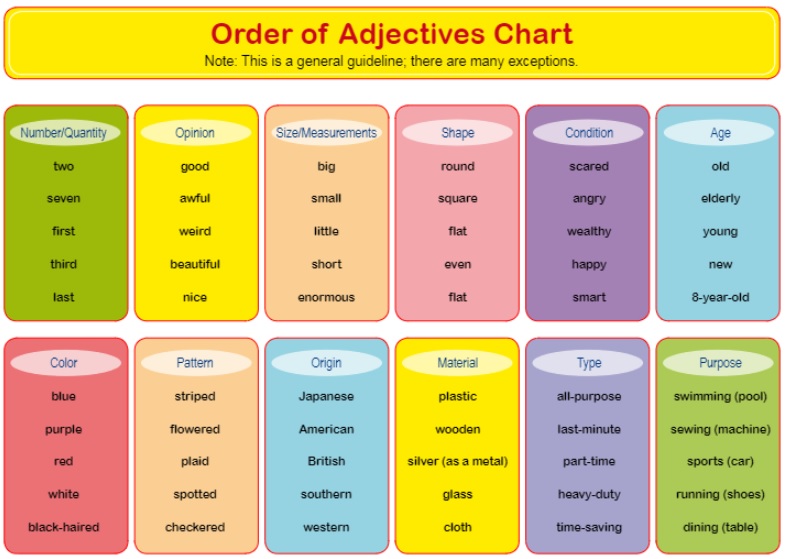
Teacher: Right. But we completely forgot about the nouns that arrived with us to this island. Let's remember them...
Children: Cornflower, river, cloud
Teacher: So that the objects that denote these words acquire a certain color, size, it is necessary to name their features using adjectives that came out to meet us. To which of the three names nouns can we pick up adjectives from this group?
Children: By the way cornflower.
Teacher: Why?
Children: Noun cornflower singular, it is masculine, like adjectives in the initial form.
Teacher: Write down the noun cornflower in your notebook and add appropriate adjectives to it on your own. At highlight the endings of adjectives, indicate the gender.
An entry appears in the notebooks: (Slide 5).
When checking, the table of generic endings of adjectives is filled in (Slide 6) endings scattered around the island appear in their respective castle windows (Slide 7).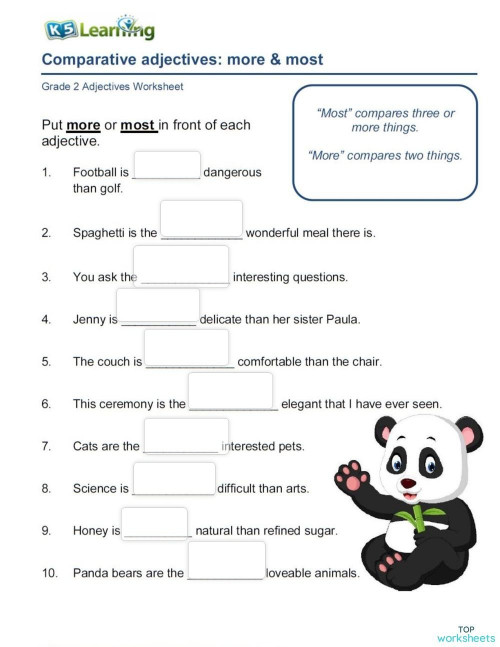
Teacher: Look, our cornflower has become not any, but very much even what? He blue, small, magical! So who will say what role they play in our language adjectives?
Children: We name the features of objects in order to accurately describe the object itself: its color, size, shape (Slide 8).
Teacher: What should be done to make these adjectives fit noun river (cloud)!
Children: It is necessary to change the endings of adjectives.
Similar work with words river and cloud (Slides 9, 10, 11, 12, 13, 14, 15, 16).
The same adjectives are attached to these nouns as attributed to the word cornflower, changing the endings accordingly.
Children highlight the endings of adjectives, indicate the gender.
Teacher: Why are adjectives that refer to a noun river, feminine, and adjectives that refer to noun cloud, neuter?
Teacher: Listen to what the inhabitants of this island say about themselves.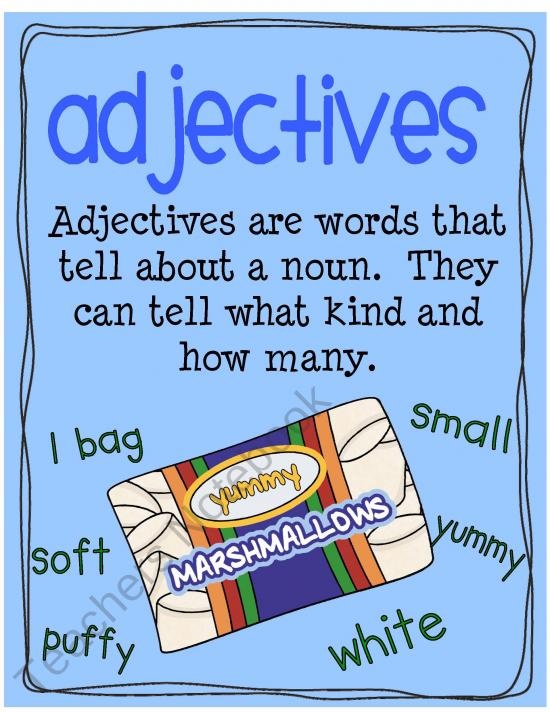
When reading a poem (Slide 17) words written on the board, children read in chorus.
For nouns sometimes
Not life, but just boredom!
They have no color without us,
No smell, no sound.
But if we apply them to us,
Then they will live more fun:
Here is Loud knock,
Here is Blue Ball,
Here is Washing blow,
Calling ball,
Ostrous sword,
Spring garden, native speech.
Teacher: Which of you was very attentive and noticed which part of speech related adjectives.
Children: With nouns.
Teacher: The title itself - an adjective - already contains a hint of the fact that the word should be “applied” to something, attached. Names adjectives are “attached” to nouns. All over with them agreeing: in gender, number, case, display their most important features, such like color, taste, quality.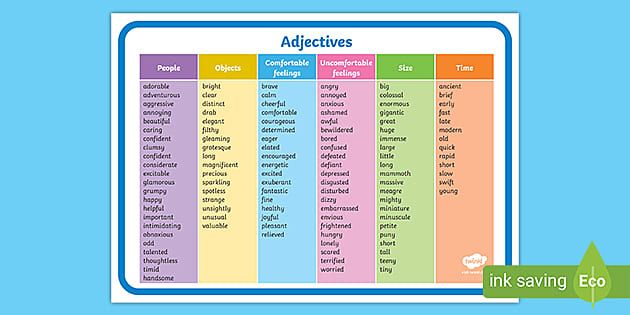 .. Continue this list (Slide 18).
.. Continue this list (Slide 18).
3. Physical education.
Slide 19.
Teacher: Get up from your desks, hands on your belt. I will call features of this subject. If I name adjectives that indicate appearance, girls squat, boys in mood. Hands in front of you.
Words are pronounced: cheerful, eared, sad, sad, tailed, joyful, spotty, thoughtful.
4. Work with the offer.
Teacher: Listen to how many sentences I read.
Wonderful in the forest in winter! Trees stand in silver frost.
Children write down sentences with comments. The second proposal is being parsed by members of the sentence, indicate the parts of speech under the words.
Teacher: Are there any adjectives in the sentence?
Children: Yes.
Teacher: What role does the adjective play in this sentence?
Children: This adjective decorates the sentence.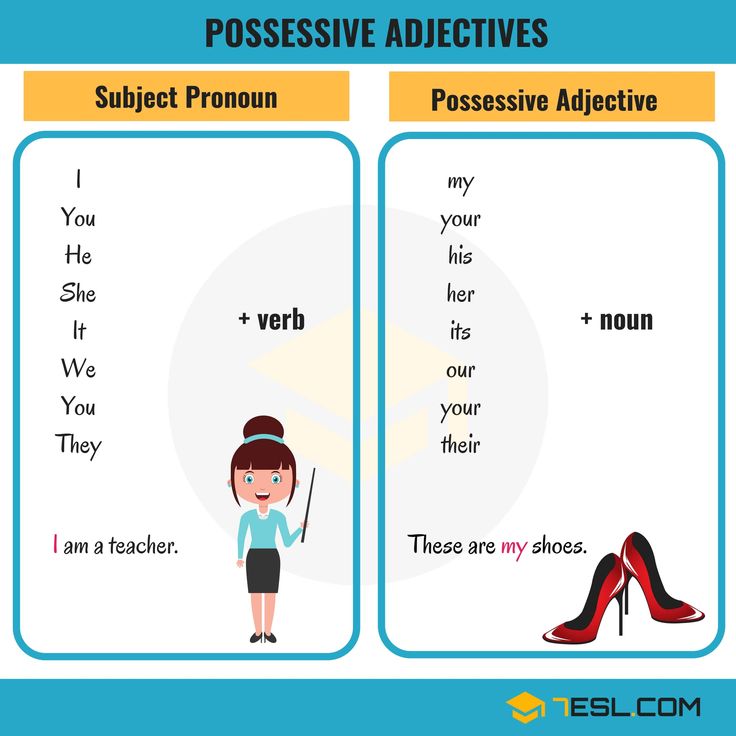
(Slide 20).
Teacher: Which part of the sentence is an adjective?
Children: Minor.
Teacher: Which noun is this adjective related to in offer?
Children: With word frost.
Teacher: Determine the gender and number of the adjective.
Children: This is a masculine singular adjective.
Teacher: How did you determine this?
Children: Put the noun in the initial form (singular, I.p.), y nouns have gender and number.
Frost - m.s., s.ch. So an adjective that agrees with given noun will be m.r., singular.
Teacher: So, in order to determine the gender and number of an adjective, you need to ...
Children read the memo in chorus (Slide 21).
Definition of generic endings for adjectives.
There are yellow and green cards on the tables.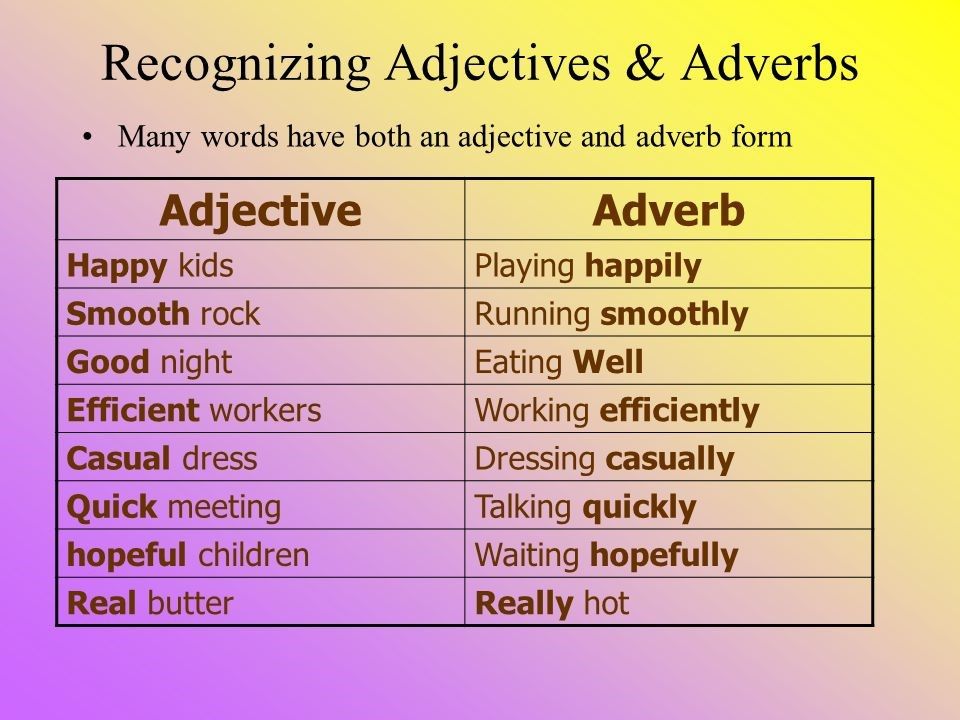 Children work in pairs options. (Annex 3)
Children work in pairs options. (Annex 3)
Teacher: Indicate the gender of adjectives.
The student reads the phrases, clearly highlighting the missing endings with his voice.
6. Development of observation, logical thinking.
Teacher: The Rulers of the Island of Adjectives Gender and Number ask you complete two tasks:
Task 1. Read the words in the columns. What part of speech is this? Determine which word in each column is “extra” explain why? (Slide 22).
Children: Words frosty and cold close in meaning. These words are synonyms. The word blizzard has a different meaning.
Teacher: Write down the synonyms in your notebook. Can they determine the genus?
Children: No, because adjectives are plural.
Task 2. On the board you see proverbs in which the words are missing large , small .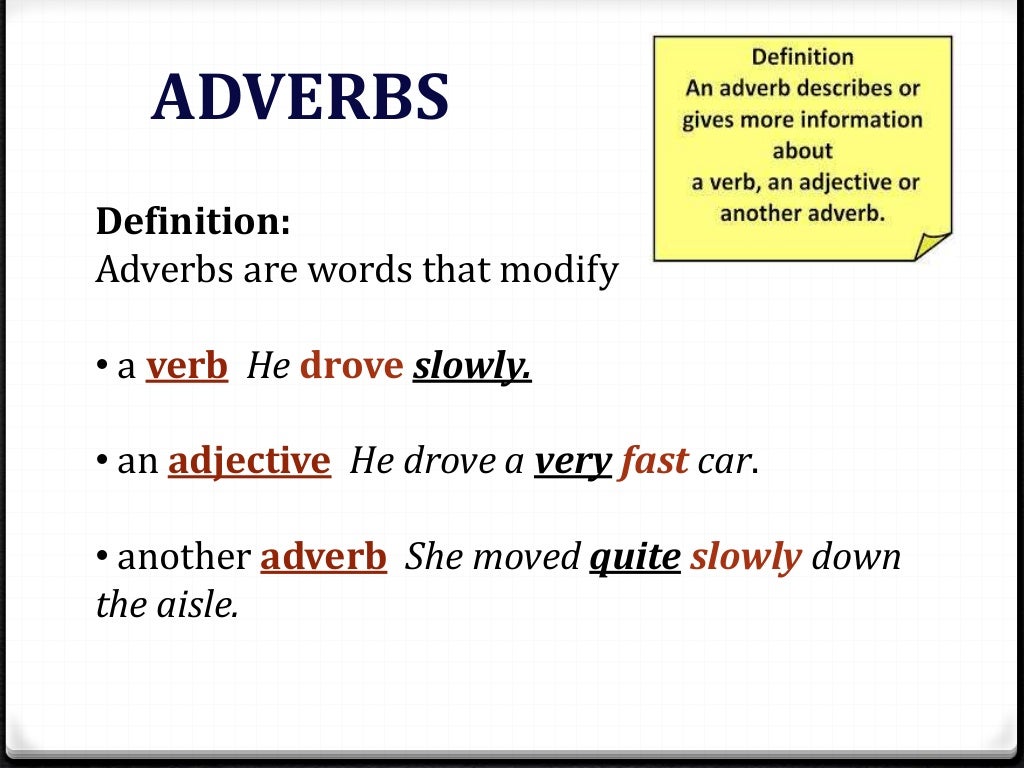 What is the meaning of the words?
What is the meaning of the words?
Children: These are words that are opposite in meaning - antonyms.
Teacher: Write down proverbs, insert appropriate meanings instead of dots adjectives. Determine the gender of adjectives. (Slide 23).
Children complete the task on their own and then check it. Goes to the board the student inserts words suitable in meaning, indicates the gender of adjectives.
7. Game “Recognize an object by its attribute”.
Teacher: Now let's play. Take each green card from the table colors, read to yourself the words that are written in them. (Appendix 4.)
Teacher: What are these parts of speech?
Children: These are nouns.
Teacher: Attention! The game is as follows. I call adjective. Each of you must choose the correct noun, which suits him, make up a phrase and write it down in a notebook, indicating the gender of the adjective. So adjective warm.
So adjective warm.
Then the teacher calls adjectives deep, low.
8. Lesson summary.
Today you visited the Island of Adjectives and learned a lot about its inhabitants. BUT now I want to check who was especially attentive in the lesson. What's new each of you learned about the adjective name?
9. Homework
Children are given cards in advance on which phrases and tasks. At home, make up a short story on the topic “Winter Day” using phrases written on the cards. (Appendix 5.)
Appendix 2.
UNDERSTANDING AND USE OF ADJECTIVES IN PRESCHOOL AND PRIMARY SCHOOL AGE | Article on the development of speech (senior, preparatory group):
UNDERSTANDING AND USE OF ADJECTIVES IN CHILDREN OF PRESCHOOL AND JUNIOR SCHOOL AGE
Author of the article Orlova E.V., GBOU "School No. 842"
Abstract. The article deals with the understanding and use of adjectives by children of preschool and primary school age. The formation of an adjective dictionary is a series of systematic activities that include a gradual and purposeful organization of a subject-developing environment that contributes to the formation of a student's cultural identity.
The formation of an adjective dictionary is a series of systematic activities that include a gradual and purposeful organization of a subject-developing environment that contributes to the formation of a student's cultural identity.
How we want to see our future largely depends on us and on the principles that we put into the minds of children. What a person is, such is his activity, such is the world that he created around him. A person's speech is, first of all, an indicator of his culture. This concept includes spirituality and morality, civilization and education, spiritual refinement and creative activity.
Man's speech is a reflection of his inner world. In this regard, the key role of an educational institution is to create optimal conditions for the comprehensive development of a child's speech potential through culture, and in particular through the culture of his people.
This task is very fully reflected in the new Federal State Educational Standard for preschool and primary school education.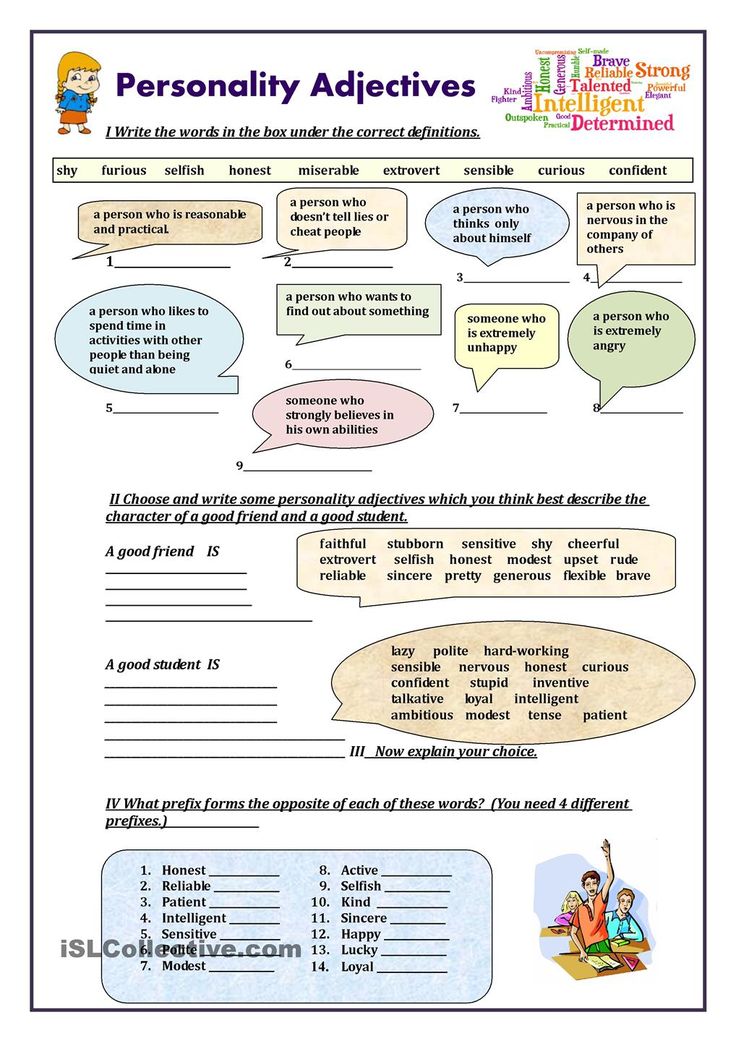 It states that the development of a bright, imaginative, correct speech of a child is one of the priority areas of development. And this is no coincidence, because competent speech is the key to future successful schooling, success in adulthood and the formation of cultural identity, a sense of belonging to the rich culture of one's people [3].
It states that the development of a bright, imaginative, correct speech of a child is one of the priority areas of development. And this is no coincidence, because competent speech is the key to future successful schooling, success in adulthood and the formation of cultural identity, a sense of belonging to the rich culture of one's people [3].
The culture of speech is a multifaceted phenomenon, its main result is the ability to speak in accordance with the norms of the literary language; this concept includes all elements that contribute to the accurate, clear and emotional transmission of thoughts and feelings in the process of communication. The correctness and communicative expediency of speech are considered the main stages of mastering the literary language (B.N. Golovin, V.G. Kostomarov, A.A. Leontiev, G.A. Zolotova).
In modern conditions, one of the dangers for literary speech is the influence of clichés, “clerical workers” (K.I. Chukovsky), which “dead living speech”.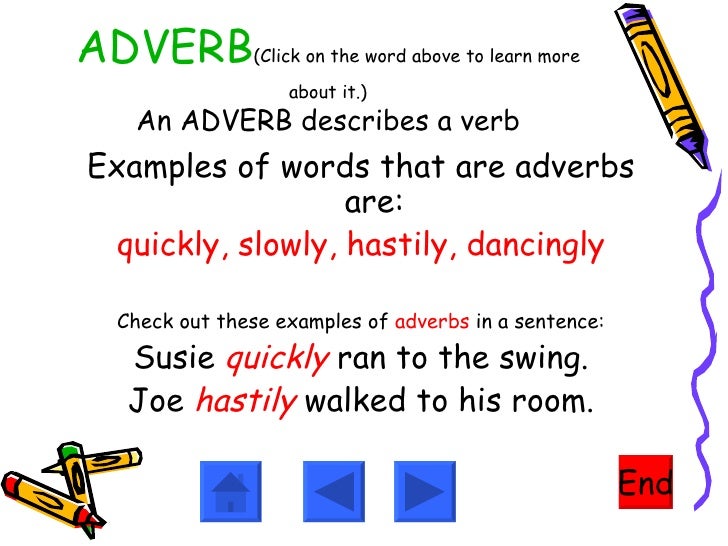 The habit of using clichés, fused blocks of official words leads to the loss of a living language, and this is reflected in its grammatical side. “Neglect of the expressiveness of speech turns into grammatical chaos,” says the book by S.V. Knyazev and S.K. Pozharitskaya "Modern Russian language" [4, p. eighteen].
The habit of using clichés, fused blocks of official words leads to the loss of a living language, and this is reflected in its grammatical side. “Neglect of the expressiveness of speech turns into grammatical chaos,” says the book by S.V. Knyazev and S.K. Pozharitskaya "Modern Russian language" [4, p. eighteen].
In school practice, a high level of speech culture is indicated by the term "good speech". This concept is included as the minimum sufficient three features: richness, accuracy and expressiveness.
The richness of speech implies a large amount of vocabulary, understanding and appropriate use of words and phrases in speech, a variety of language means used in speech.
Accuracy of speech can be considered as optimal word usage: it is the choice of words that best convey the content of the statement, reveal its theme and main idea in a logical sequence. It is very important to possess synonymy, to distinguish between the meanings of the semantic shades of the word.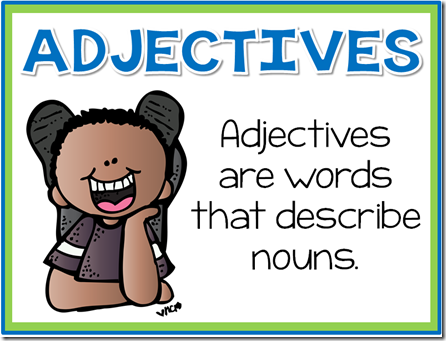
And, finally, the expressiveness of speech involves the selection of language means that correspond to the conditions and tasks of communication. This quality must necessarily be correlated with the functional style, understanding of the situation, in order to take into account the specifics of speech conditions when choosing words and expressions [4].
These provisions are reflected in the study of N.V. Gavrish "Formation of figurative speech of older preschoolers in the process of teaching their native language." The problem itself was solved in several directions: as work on children's mastery of all aspects of speech (phonetic, lexical, grammatical), perception of various genres of literary and folklore works, and as the formation of the language design of an independent coherent statement [1].
Preschool age is a period of rapid development of children's speech, and especially their vocabulary. Its growth depends on the child's living conditions, his upbringing, therefore, in the literature, data on the number of words in preschoolers of the same age vary greatly.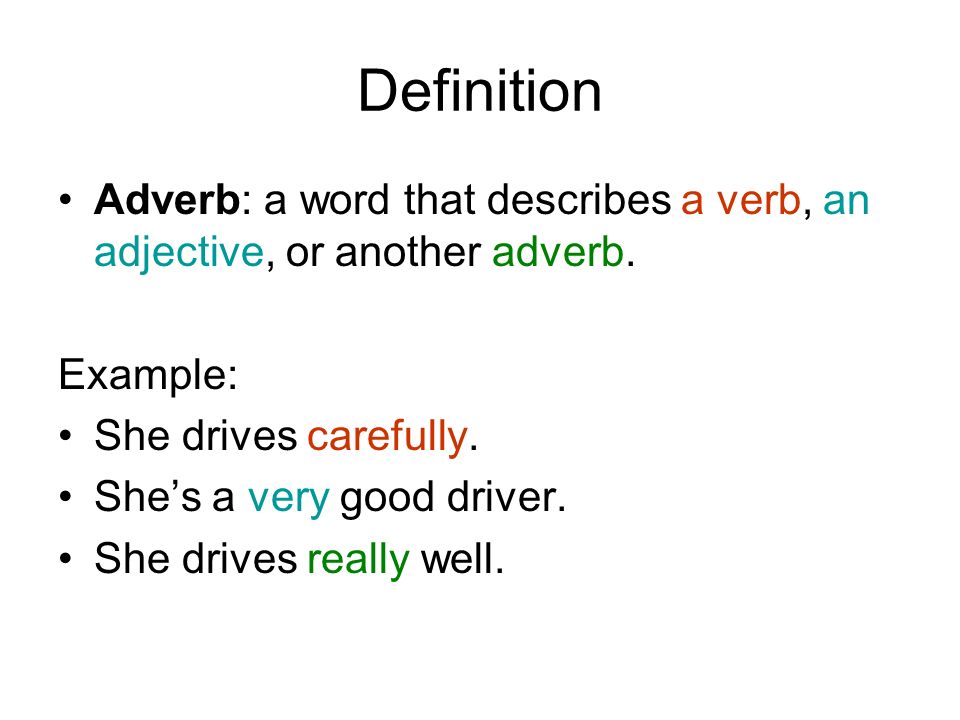 The number of nouns and verbs increases especially rapidly, the number of adjectives used grows more slowly [2].
The number of nouns and verbs increases especially rapidly, the number of adjectives used grows more slowly [2].
Our study showed that children of 6-7 years old characterize an object mainly by 1-2 standard features. The children were given two nouns: cat and cloud. It was necessary to characterize these objects, almost all the children said that the cat is gray and small, and the cloud is white and large. What is the reason for such a poverty of the vocabulary of adjectives in children? This is explained, firstly, by the conditions of upbringing (adults admitted that they pay little attention to the acquaintance of children with the signs and qualities of objects), and secondly, the culture of joint reading of adults and children has practically disappeared in families, and in fact it is fairy tales, nursery rhymes, proverbs and sayings are an inexhaustible source of bright, figurative, adjective-saturated speech, thirdly, the nature of the adjective as the most abstract form of speech [1].
Research by Yu.S. Lyakhovskaya showed that the most common nouns in the speech of children, mainly denoting specific objects. Children know the common names of items of clothing, washing accessories, food, dishes. They also know the details (collar, pockets, sleeves, etc.). But the names of some details are not used and they are not even always known (tape, shoulder strap, inside out, etc.). Often children replace unfamiliar nouns with verbs: “What they hang on is a hanger ...” [5]. As a rule, these lexical errors in children's speech are caused by the poverty and indistinctness of children's ideas about objects and their characteristic features. It is no coincidence that E.I. Tikheeva noted that vague ideas will never find a clear and sensible verbal expression [1].
The main form of verbs used by children are words denoting movement (go, bring), specific actions, most often labor (tie, put on, fold, etc.), verbs showing physical and mental state (hungry, wake up, etc. .), the activity of the senses, thinking (look, think up, shine, etc.). In the speech of children of older preschool age, there is an imperative mood, but its use is situational, in contrast to the younger age. For example: "Pick up your toys" - to the younger brother after playing together. When creating certain conditions, children also use the subjunctive mood [1].
.), the activity of the senses, thinking (look, think up, shine, etc.). In the speech of children of older preschool age, there is an imperative mood, but its use is situational, in contrast to the younger age. For example: "Pick up your toys" - to the younger brother after playing together. When creating certain conditions, children also use the subjunctive mood [1].
In more detail, we will dwell on the features of the assimilation of adjectives by children. Despite the fact that individual adjectives are found in the speech of children quite early (usually in the second half of the second year), children use them in small quantities. They use in their speech qualitative adjectives, adjectives denoting color, some spatial concepts (big, small), external physical or bodily qualities of people (fat, thin, bald, etc.), qualities (sweet, hot).
There are also relative adjectives expressing attitude to a person (children's fun), to an action (washing tap), to time (lunch hour), to a number (double blanket).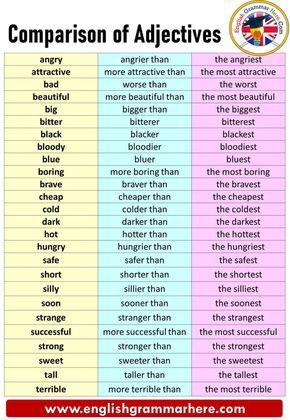 Possessive adjectives are rare. During the time of our research, we practically did not meet short forms of adjectives. Occasionally there are degrees of comparison of quality adjectives and adjectives that play the role of epithets (cheerful, beautiful, good). And this is no coincidence, because adjectives with the meaning of a general assessment are one of the oldest groups of words with an abstract meaning, rooted in the origins of the Old Slavonic language and pre-Christian culture. General appraisal lexemes express the main worldview categories, positive and negative attitudes towards the phenomena of reality - good and evil, good and bad. It is not surprising that words with the semantics of a general assessment primarily attract the attention of children, and it is they that are found in large numbers in songs, nursery rhymes, fairy tales, which is what the child first of all gets acquainted with, plunging into the world of his native culture.
Possessive adjectives are rare. During the time of our research, we practically did not meet short forms of adjectives. Occasionally there are degrees of comparison of quality adjectives and adjectives that play the role of epithets (cheerful, beautiful, good). And this is no coincidence, because adjectives with the meaning of a general assessment are one of the oldest groups of words with an abstract meaning, rooted in the origins of the Old Slavonic language and pre-Christian culture. General appraisal lexemes express the main worldview categories, positive and negative attitudes towards the phenomena of reality - good and evil, good and bad. It is not surprising that words with the semantics of a general assessment primarily attract the attention of children, and it is they that are found in large numbers in songs, nursery rhymes, fairy tales, which is what the child first of all gets acquainted with, plunging into the world of his native culture.
Working with children on works of oral folk art, we not only enrich the vocabulary of children, but also introduce children to the traditions of not only their people, but the culture of the peoples of the world.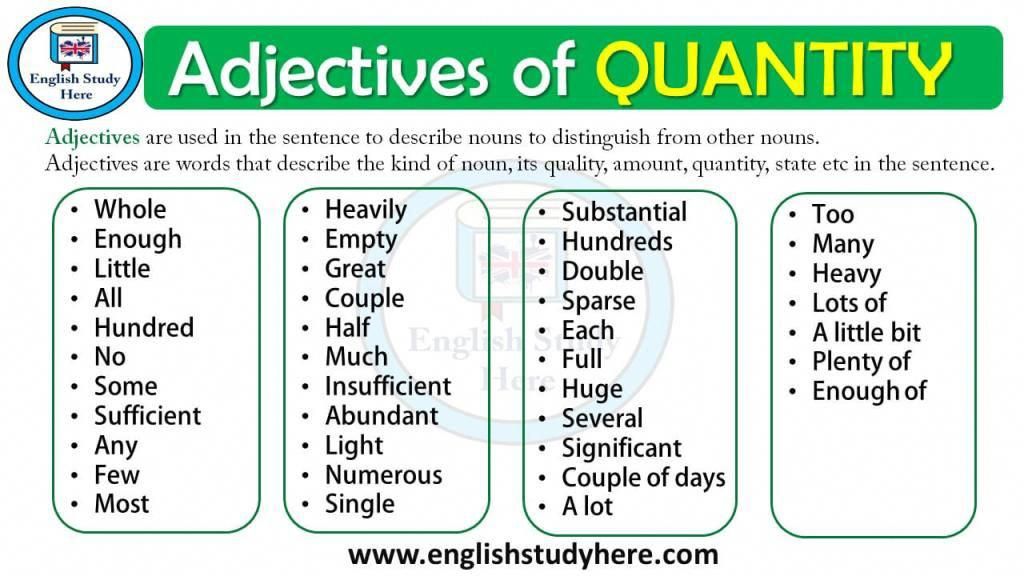 Working on the assimilation of adjectives allows us to develop the child's speech in an interesting form for the child and form his cultural identity.
Working on the assimilation of adjectives allows us to develop the child's speech in an interesting form for the child and form his cultural identity.
Thus, the analysis of adjectives used by children showed that children have little understanding of the essential features of objects. In the active dictionary, words denoting size (long, short, narrow, wide) are almost never used, despite the fact that these words are used quite often in the GCD process and the daily routine of the preschool educational institution, the condition of the object (wet, dusty, new, shabby) . There are rare cases of the correct designation of the material (woolen, fur), mostly children use nouns (from wool, from fur). Do not use words denoting seasonality (summer, winter, autumn, etc.). Sometimes adjectives are replaced by verbs: "Soap dish ... consists of pieces of iron" [1].
Knowing the peculiarities of the development of the vocabulary of adjectives in children of older preschool age and classifying the main speech errors of children of a given age, it is possible to most effectively build a dictionary, to choose the most suitable methods and techniques for children of this age.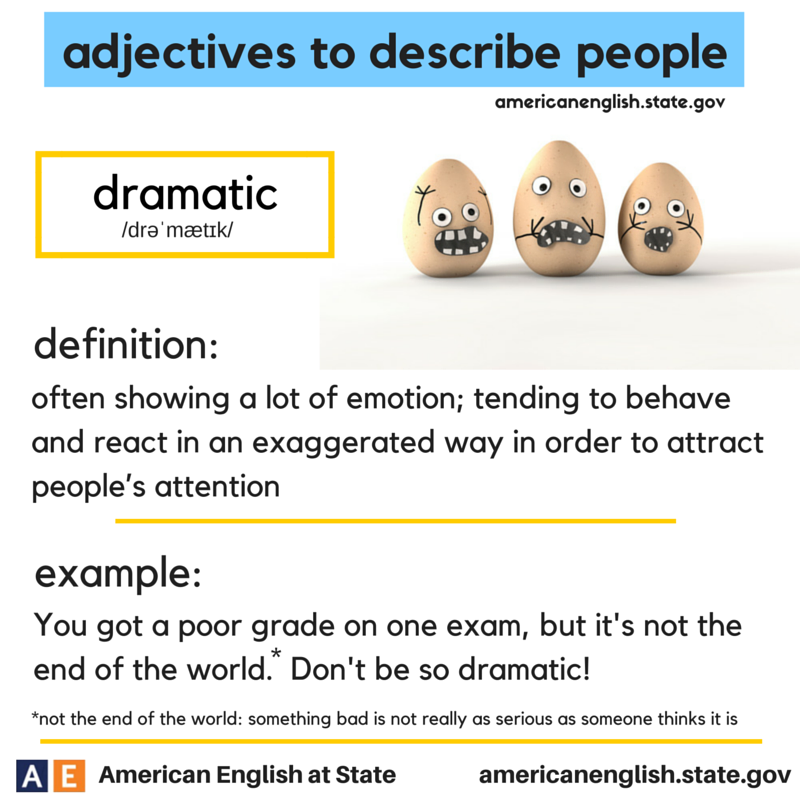
Based on the conducted research, we can draw the following conclusions: work on the formation of a vocabulary of adjectives in children of older preschool age should be carried out in the following areas:
• increasing the vocabulary of children
• clarifying the meanings of words
• fixing them in the child's memory and teaching him to use his vocabulary more widely
Children must have a clear idea of the objects and phenomena of the immediate environment (family, kindergarten, school, street, etc.) and correctly name what they are dealing with, what they encounter in their activities. This includes a household dictionary: the name of professions and labor activities, tools; abstract concepts: designation of time, space, quantity; designation of moral qualities, relations. In the active dictionary of children there should be not only the names of objects, but also the names of actions, states, signs (color, shape, size, taste). But at the same time, teachers must be warned against introducing pedagogical terms into the speech of children, such as “visual dictation”, “decorative drawing”, “didactic game”, etc.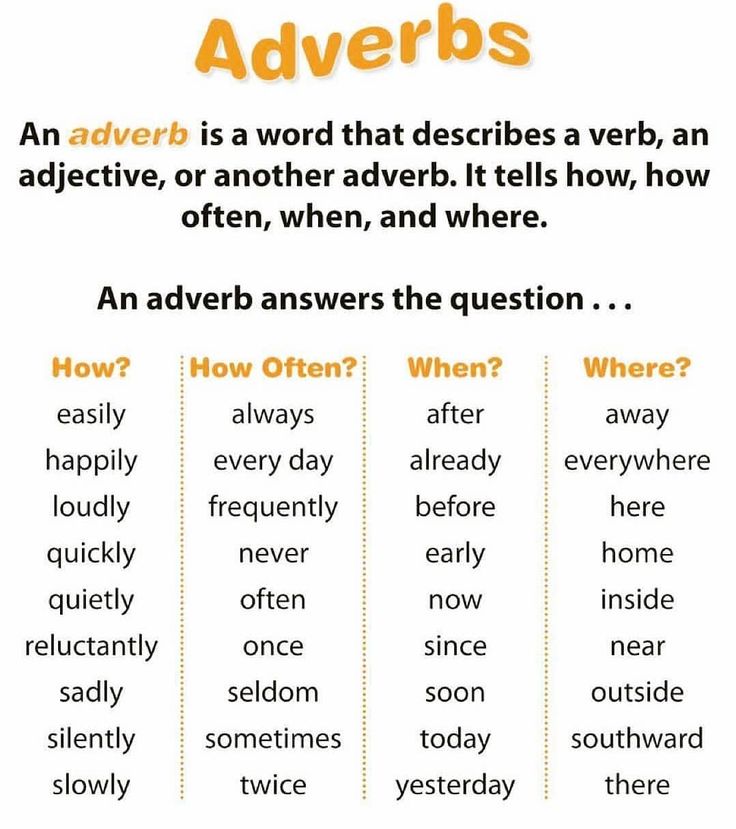 [2].
[2].
Also, we must not forget that the work on expanding and clarifying the vocabulary of adjectives is closely related to expanding their activities and horizons through games, observations, walks, conversations, caring for plants, stories of the educator, reading fiction and works of oral folk art.
In elementary school, work on the formation of a dictionary of adjectives should also continue in the three areas we have identified earlier, since one of the components of the methodology for teaching the Russian language is the method of developing speech, which is based on vocabulary, work with text, morphology.
Great opportunities for the development of the speech of an elementary school student are given by the study of the name of the adjective in the Russian language lessons. There are many studies on this issue. In particular, N.K. Nikitina suggests that in grade 1, practice compiling sentences and short texts based on subject pictures, since children more easily learn adjectives along with nouns and verbs.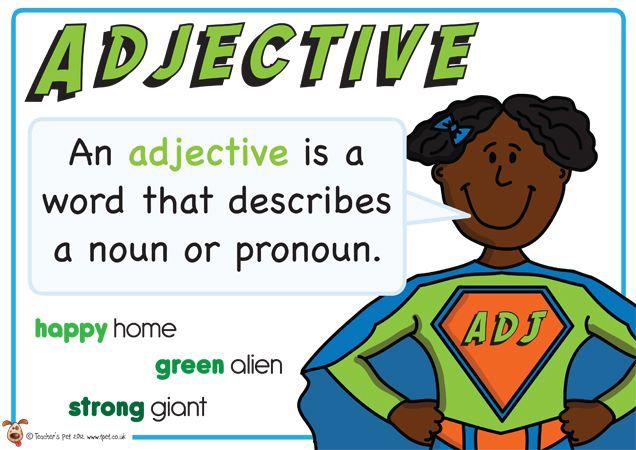 This makes it easier to memorize and understand the semantic meaning of the word. In grade 2 - spreading a coherent text by inserting missing adjectives into it. since the passive vocabulary of adjectives among schoolchildren is already quite large and we are faced with the task of activating it:
This makes it easier to memorize and understand the semantic meaning of the word. In grade 2 - spreading a coherent text by inserting missing adjectives into it. since the passive vocabulary of adjectives among schoolchildren is already quite large and we are faced with the task of activating it:
• selection of words denoting an object, words denoting a sign, work on riddles, including an adjective showing signs of an object that serves as a guess;
• formation of adjectives from nouns and writing phrases with these adjectives: "What are the guys who are friends called? - friendly guys; what is the name of the bookcase? - bookcase", etc.).
In grades 3-4, preference is given to independent observations of the role of the adjective in a literary text and to compiling your own examples of the use of phrases.
The main task of elementary school is the development of students' speech. One of the sides of this task is to enrich the vocabulary of children. Children master the language long before school.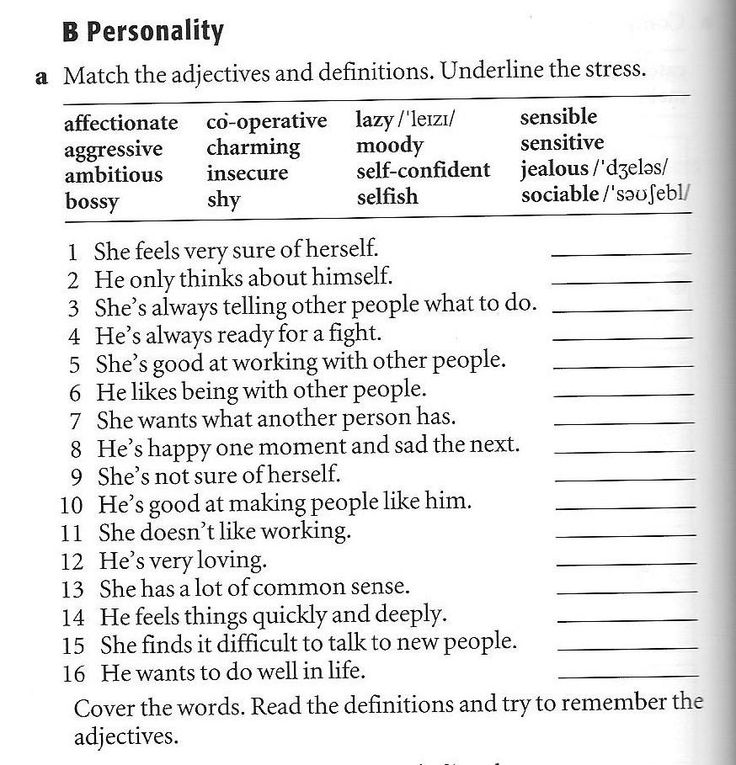 However, the active vocabulary is very poor.
However, the active vocabulary is very poor.
It is believed that the expansion of the dictionary should not be due to an increase in speech units, but by improving the semantics of each word.
Learning adjectives in elementary school is very interesting and beneficial not only in terms of the development of students' speech, but also the formation of cultural identity. M.R. Lvov found that "the achievement of the peak of intensity" of adjectives is ahead of their systematic study in the school course of the Russian language and falls on the 3rd grade. Therefore, it is necessary to look for ways and opportunities to enrich the speech of primary school students with adjectives even before the "peak intensity" in the 1st grade, especially in the 2nd grade. Such enrichment is very important, since it is the indicative words that make the speech expressive and vivid, i.e., pictorial [5].
In elementary school, it is very important to continue working on works of oral folk art, it can be noted that fairy tales, riddles, sayings, proverbs are a real treasury of folk wisdom, exceptional examples of the language of the people.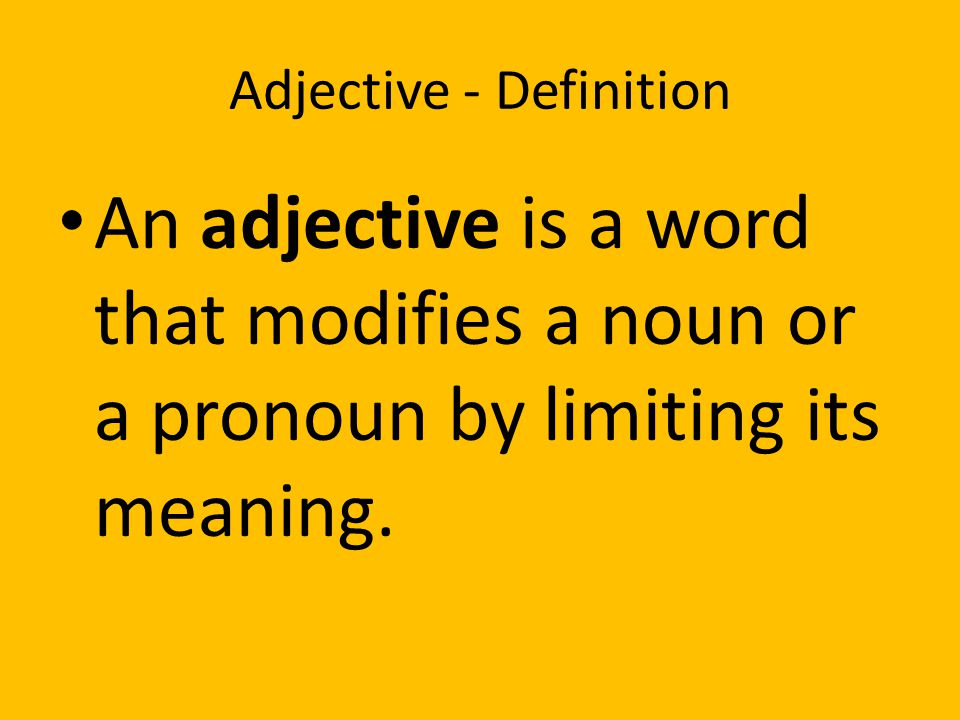 Folk art reflects and historically preserves the traits of character and thinking inherent in the people. Through a native song, a fairy tale, a game, mastering the native language, the child receives the first ideas about the culture of his people, the peculiarities of his language, folk traditions, feels his involvement with his history.
Folk art reflects and historically preserves the traits of character and thinking inherent in the people. Through a native song, a fairy tale, a game, mastering the native language, the child receives the first ideas about the culture of his people, the peculiarities of his language, folk traditions, feels his involvement with his history.
In the sense of clarifying and enriching the active vocabulary of children, the significance of synonymy is enormous. Synonymy in a language testifies to the richness and expressive possibilities of a given language. M.R. Lvov rightly notes that "the more synonyms in the dictionary, the richer the expressive possibilities of both the given language as a whole and each of its native speakers." Synonymous means of language allow you to accurately and figuratively express an idea. Exercises on synonyms expand and refine the vocabulary of students, contribute to the accurate expression of thoughts, and prevent the repetition of the same word [3].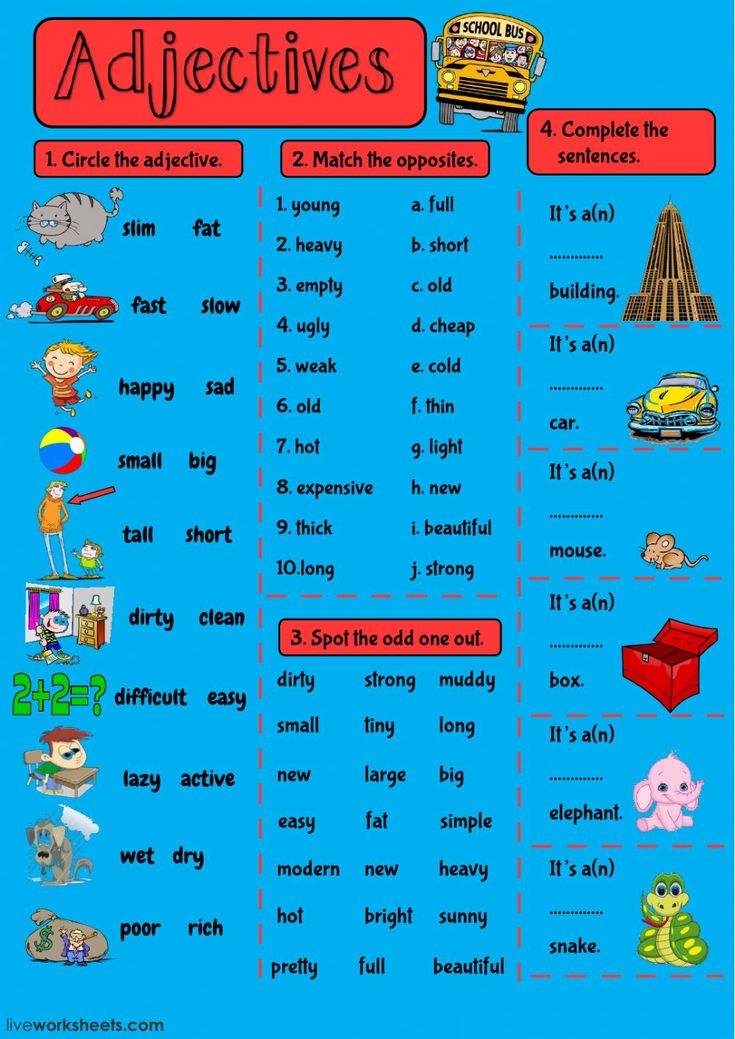
Domestic psychologists have proven that the most receptive and favorable age in terms of language development is primary school age. Proceeding from this, work on the formation of a dictionary of adjectives, through work on synonyms. antonyms, polysemantic words should be purposefully and systematically carried out in primary grades [4]. Firstly, the number of synonymous words should be gradually accumulated in the individual speech of each child, and secondly, it is necessary that children realize that the considered adjectives, although they are close in meaning, there are many words among them that differ in shades of meanings.
A fertile material for the development of students' speech is the use of connected text saturated with adjectives.
Adjectives in their expressive qualities cannot be compared with any part of speech. The importance of enriching the child's vocabulary with adjectives was pointed out by N.S. Christmas. He wrote: "The enrichment of the child's vocabulary with adjectives is important because with their help the child singles out in objects, persons and phenomena those qualities that are comprehended by him as the most important for him in terms of their vital significance in connection with his interests and needs" [5 ].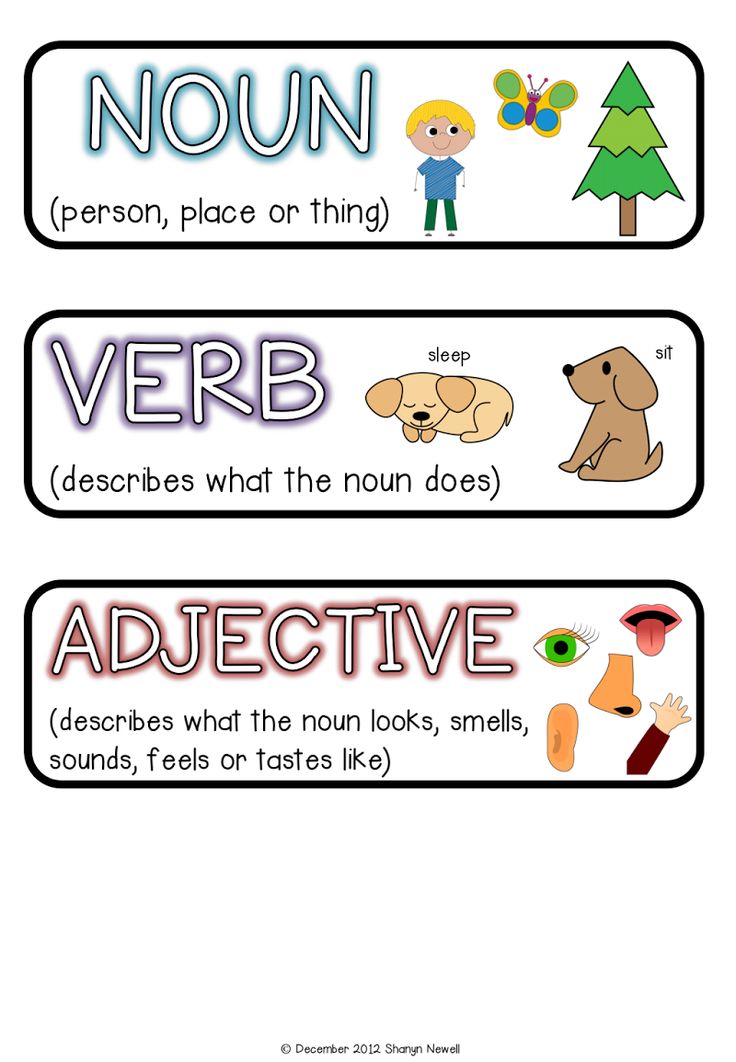
So, one of the priority areas for the development of the personality of a child of preschool and primary school age is the development of speech development, since by developing speech, a person actively develops thinking, feelings, and acquires full-fledged communication skills.
The most relevant work on the development of speech in preschool age and no less relevant in elementary school. Children aged 6-7 come to school, who use from 3 to 5 thousand words and practically know the grammar of their native language, that is, they correctly decline and conjugate words, build sentences. Starting to comprehend the basics of science, students learn many special words, book constructions - master the educational and scientific style of speech. However, the development of their coherent speech is inhibited: the speech of children becomes less relaxed and emotional, more stereotyped. But we need to “include the student in a multifaceted seething community, give him the opportunity to be an active member of society, understanding others and able to be understood by others [1].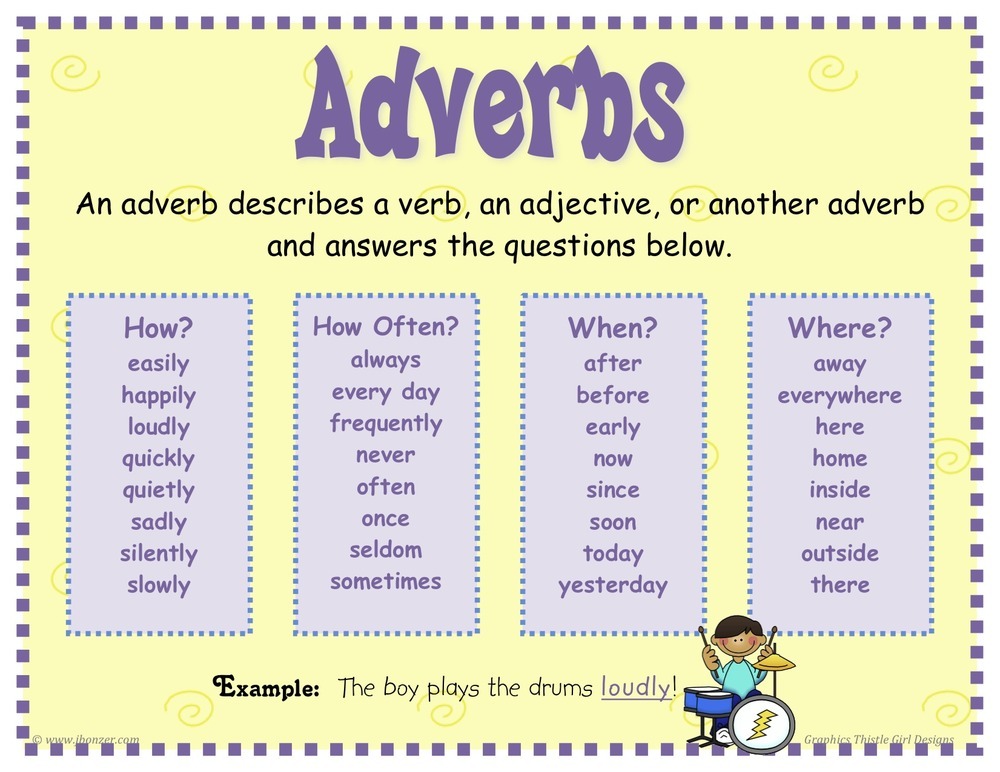
And the sooner we start developing the unique gift of words in children, the sooner we will achieve the desired results. And for this it is necessary to develop the speech of younger schoolchildren - children of that age period when they still have the ability to "absorb" speech and they have already formed a readiness to master the varieties of coherent speech.
The child's colloquial speech is closely connected with the formation of interest in speech in general and in one's own speech in particular, with the need to improve and enrich it. This work must begin from the first days of the child's stay in an educational institution.
The task of both the preschool teacher and the primary school teacher is to reveal in an accessible form for the child the main functions of speech as a means of communication, transmission and assimilation of certain information, organizing and planning activities, influencing thoughts, feelings, people's behavior.
In the process of studying any topic, the subject of constant attention should be not only the development of students' conscious and accurate use of the phenomenon being studied, but also the formation of the cultural identity of a pupil of a preschool educational institution or a primary school student. Work on the formation of a dictionary of adjectives presents unlimited possibilities for this.
Work on the formation of a dictionary of adjectives presents unlimited possibilities for this.
So, as one of the main tasks of implementing the content of the subject area "Philology" in elementary school [4, p. 19] advocates the formation of "initial ideas about the unity and diversity of the linguistic and cultural space of Russia, about language as the basis of national identity." At the same time, it should be emphasized that the category "nation" implies "double use" AND, if the basis of national (general civil, all-Russian) identity is "basic national values" (values of civil society) "and a common historical fate" presented in the "Approximate main educational program of an educational institution for elementary school, the very topical issue of national (ethno-cultural) values realized through general educational disciplines, Russian (native) language in particular, remains open.0005
An important factor in the development of national value relations, attitudes to the world, in addition to the cognitive aspect - understanding the content of the concept and forms of manifestation (enrichment of the vocabulary of adjectives), - should become emotional and semantic - direct living by younger students of these relations in interaction with the real surrounding reality (activation dictionary of adjectives in the classroom and in everyday life).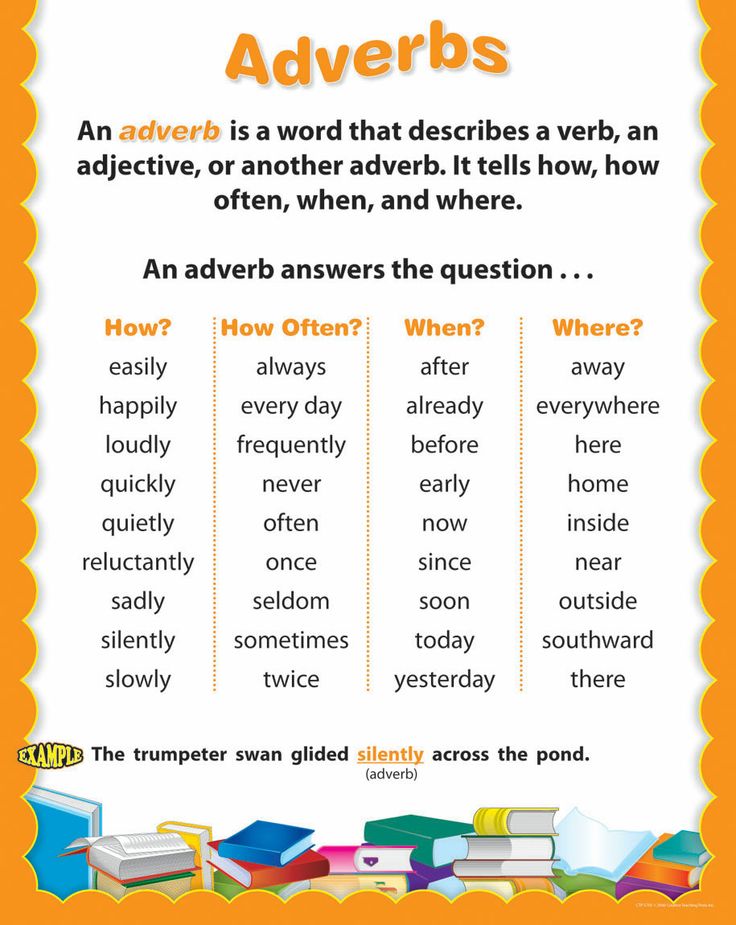
In the paradigm of personal development education, it is extremely difficult to ensure the full assimilation of the values of national culture by students without the basic concepts of the methodology of teaching the Russian (native) language - phonetics, vocabulary, morphology, grammar. The content shades of nominative units, seeking to reflect the ethnic specificity of the presentation of linguistic knowledge, lie in a different perception of the surrounding reality. So, if the concept-semantics of the word is connected, first of all, with knowledge (consciousness, cognition) - meaning, logic, reason (conscious perception), then this knowledge is based on the "soul" (spirit) - feelings, sensations, experiences, spiritual activities. And as we have already indicated above, most of the adjectives that children learn in the first place refer specifically to words with conscious (spiritual perception).
Work on the formation of a dictionary of adjectives in preschool and primary school age contributes to the practical implementation of the awareness of preschoolers by younger students of national (ethnocultural) values when working on the development of speech in the paradigm of personality-oriented education, can and should enrich students with the content of national culture, folk traditions (work over the works of oral folk art), moral foundations (acquaintance with the holidays and traditions of their people), to promote the disclosure of a holistic national linguistic picture of the world (work on a dictionary of adjectives as a qualitative characteristic of the language), to promote the spiritual and moral development of preschoolers and younger schoolchildren, their national identity (awareness of one's ethnicity) and, on this basis, ensure integration into the national (all-Russian) and world culture.